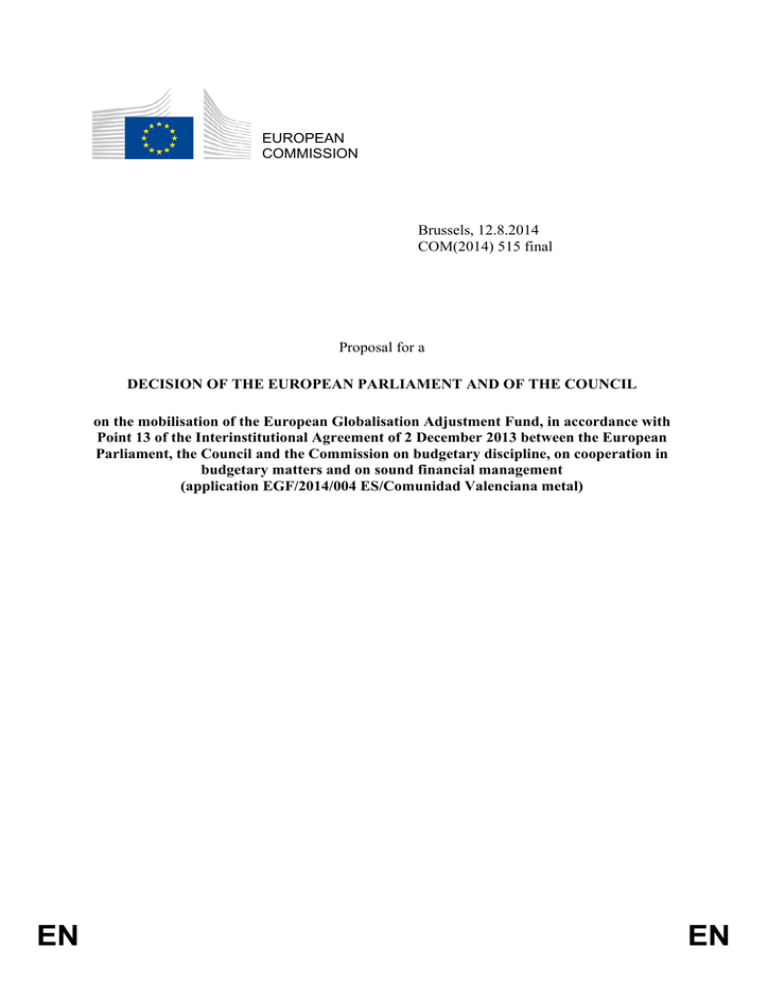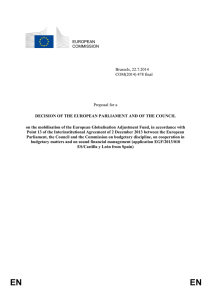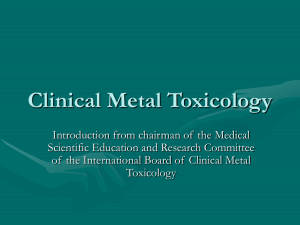
EUROPEAN
COMMISSION
Brussels, 12.8.2014
COM(2014) 515 final
Proposal for a
DECISION OF THE EUROPEAN PARLIAMENT AND OF THE COUNCIL
on the mobilisation of the European Globalisation Adjustment Fund, in accordance with
Point 13 of the Interinstitutional Agreement of 2 December 2013 between the European
Parliament, the Council and the Commission on budgetary discipline, on cooperation in
budgetary matters and on sound financial management
(application EGF/2014/004 ES/Comunidad Valenciana metal)
EN
EN
EXPLANATORY MEMORANDUM
CONTEXT OF THE PROPOSAL
1.
The rules applicable to financial contributions from the European Globalisation
Adjustment Fund (EGF) are laid down in Regulation (EU) No 1309/2013 of the
European Parliament and of the Council of 17 December 2013 on the European
Globalisation Adjustment Fund (2014-2020) and repealing Regulation (EC)
No 1927/20061 (the 'EGF Regulation').
2.
The Spanish authorities submitted application EGF/2014/004 ES/Comunidad
Valenciana metal for a financial contribution from the EGF, following redundancies
and cessation of activities within the meaning of Article 3 of the EGF Regulation
(here after referred as 'redundancies') in 142 enterprises operating in the NACE
Revision 2 division 25 (Manufacture of fabricated metal products, except machinery
and equipment)2 in the NUTS level 2 region of Comunidad Valenciana (ES52).
3.
After a thorough examination of this application, the Commission has concluded, in
accordance with the applicable provisions of the EGF Regulation, that the conditions
for awarding a financial contribution from the EGF are met.
SUMMARY OF THE APPLICATION
EGF application:
EGF/2014/004 ES/Comunidad Valenciana
metal
Member State:
Spain
Region(s) concerned (NUTS 2 level):
Colunidad Valenciana (ES52)
Date of submission of the application:
25.3.2014
Deadline for acknowledgement of receipt of the
application and for request for additional
information
7.4.2014
Deadline for provision of additional information:
20.5.2014
Deadline for completion of the assessment:
12.8.2014
Intervention criterion:
Article 4(1)(b) of the EGF Regulation
Sector(s) of economic activity (NACE Rev. 2
division):
Division 25 ('Manufacture of fabricated
metal products, except machinery and
equipment')
Reference period (nine months):
1.4.2013 – 31.12.2013
Number of redundancies or cessations of activity
during the reference period:
633
Number of eligible beneficiaries expected to
participate in the measures:
Budget for personalised services
Budget for preparatory, management,
information, and publicity
1
2
EN
300
EUR 1 622 640
EUR 76 000
OJ L 347, 20.12.2013, p. 855.
Regulation (EC) No 1893/2006 of the European Parliament and of the Council of 20 December 2006
establishing the statistical classification of economic activities NACE Revision 2 and amending Council
Regulation (EEC) No 3037/90 as well as certain EC regulations on specific statistical domains (OJ L
393, 30.12.2006, p. 1).
2
EN
Total budget
Financial contribution requested from the EGF
EUR 1 698 640
EUR 1 019 184 (60 % of total costs)
ASSESSMENT OF THE APPLICATION
Procedure
4.
The Spanish authorities submitted application EGF/2014/004 ES/Comunidad
Valenciana metal within 12 weeks of the date on which the intervention criteria set
out in paragraphs 5 to 7 below were met, on 25 March 2014. The Commission
acknowledged receipt of the application within two weeks of the date of submission
of the application, on 7 April 2014. On the same date the Commission requested
additional information from the Spanish authorities. Such additional information was
provided within six weeks of the date of the request. The deadline of 12 weeks of the
receipt of the complete application within which the Commission should finalise its
assessment of the application's compliance with the conditions for providing a
financial contribution expires on 12 August 2014.
Eligibility of the application
Intervention criteria
5.
The Spanish authorities submitted the application under the intervention criterion of
Article 4(1)(b) of the EGF Regulation, which requires at least 500 workers being
made redundant over a reference period of nine months in enterprises operating in
the same economic sector defined at NACE Rev. 2 division level and located in one
region or two contiguous regions defined at NUTS 2 level in a Member State.
6.
The application relates to workers made redundant or ceasing their activities3 in 142
enterprises4 operating in the NACE Rev. 2 division 25 (Manufacture of fabricated
metal products, except machinery and equipment) in the NUTS 2 level region of
Comunidad Valenciana (ES52).
7.
The reference period of nine months is from 1 April 2013 to 31 December 2013.
Calculation of redundancies and of cessation of activity
8.
The redundancies have been calculated as follows:
–
380 from the date on which the employer, in accordance with Article 3(1) of
Council Directive 98/59/EC5, notified the competent public authority in writing
of the projected collective redundancies. The Spanish authorities confirmed
prior to the date of the completion of the assessment by the Commission that
these 380 redundancies have actually been effected; and
–
253 from the date of the de facto termination of the contract of employment or
its expiry within the reference period.
Eligible beneficiaries
9.
The total number of eligible beneficiaries is 633.
Link between the redundancies and the global financial and economic crisis addressed in
Regulation (EC) No 546/2009
3
4
5
EN
Within the meaning of Article 3of the EGF Regulation.
For the list of the enterprises concerned and the number of workers made redundant in each enterprise
see annex1.
Council Directive 98/59/EC of 20 July 1998 on the approximation of the laws of the Member States
relating to collective redundancies (OJ L 225, 12.8.1998, p. 16).
3
EN
10.
In order to establish the link between the redundancies and the global financial and
economic crisis addressed in Regulation (EC) No 546/2009, the Spanish authorities
argue that the metal products sector is a key provider of inputs to a wide range of
manufacturing activities, in particular the shipbuilding, construction and automotive
sectors. All of these were significantly impacted across the European Union by the
economic crisis, as previously recognised by the Commission6 and its services7. In
addition the arguments presented in previous EGF applications related to these
sectors remain valid8, in particular those put forward in the context of two EGF
applications from Spain related to the same sector9.
Industrial production index
(2010 = 100)
Source: Eurostat
11.
6
7
8
9
EN
As shown in the chart above, between the years 2000 and 2007, i.e. before the
financial and economic crisis, the average annual growth of the industrial production
index in the EU-28 had been approximately 1,7 %; in Q1 2008, the index for the
EU 28 reached its maximum level (112,8). Between April 2008 and April 2009
industrial production in the EU-28 dropped by more than 22 percentage points.
Afterwards however a relatively dynamic recovery set in for about two years. Since
May 2011 industrial production has again fallen. The EU’s average industrial
production index for 2013 is comparable to the level in 2003.
COM(2009) 104 final of 25.2.2009, "Communication from the Commission on "Responding to the
crisis in the European automotive industry".
Eurostat – Statistics in focus 61/2011 on Industry, trade and services, "EU-27 Construction activity falls
by 16 % from its pre-crisis high by the second quarter of 2011",
http://epp.eurostat.ec.europa.eu/cache/ITY_OFFPUB/KS-SF-11-061/EN/KS-SF-11-061-EN.PDF
For the shipbuilding industry, see: EGF/2010/006 PL/H. Cegielski-Poznan, EGF/2010/025 DK/Odense
Steel Shipyard and EGF/2011/008 DK/Odense Steel Shipyard.
For the construction sector, see: EGF/2011/006 ES/Comunidad Valenciana Construction,
EGF/2011/009 NL/Gelderland Construction 41, EGF/2011/012 NL/Noord Brabant-Zuid Holland and
EGF/2011/017 ES/Aragón Construction.
For the automotive sector, see: EGF/2009/019 FR/Renault, EGF/2010/002 ES/Cataluña Automotive
and 2011/003 DE/Arnsberg and Düsseldorf Automotive.
COM (2012) 451 related to EGF/2011/019 ES/Galicia Metal and COM (2012) 620 related to
EGF/2011/018 ES País Vasco Metal.
4
EN
12.
In Spain, the average annual growth of the industrial production index followed the
same trend as the EU-28 until 2007. However, between April 2008 and April 2009,
industrial production in Spain declined by almost 27 percentage points (five points
more than at EU-28 level) and since then industrial production has not recovered and
there has been a relatively steady decline. Spain’s average industrial production
index for 2013 is comparable to the level in 1994.
13.
Spain is among the Member States most seriously affected by the global financial
and economic crisis. The gloomy industrial prospects resulting from the global
financial and economic crisis consequently led to a lower demand for, and
production of, metal and metal products. In Spain the production of metal products
decreased by 23,3 % in 2009 compared with the previous year and by 36,6 %
between 2008 and 2013.
Production of metal products (NACE Rev. 2 division 25) in Spain
(volume index of production 2010 = 100)
Source: Eurostat
14.
The decrease of production in the industry had consequences for employment. Spain
thus lost almost 600 000 jobs in the industry between 2008 and 2012, of which
150 000 in the sector of manufactured metal products. These job losses represent
respectively 24 % of total employment in the industry and 35 % of total employment
in the metal sector.
15.
The job losses in the metal sector in Comunidad Valenciana have been even greater.
In 2008, there were 35 868 jobs in the metal sector in Comunidad Valenciana, while
in 2012 the number of jobs had decreased to 20 873. This represents a decline by
43 %, eight percentage points higher than at national level.
Events giving rise to the redundancies and cessation of activity
16.
EN
The events giving rise to the redundancies is the sharp decline in production of
fabricated metal products in Comunidad Valenciana as a consequence of the
financial and economic crisis. The turnover of the sector decreased by 38,5 % in the
period 2008-2012, thus resulting in redundancies and other adjustments such as
temporary suspension of work and reduction of working hours.
5
EN
17.
The jobs in the metal sector in Comunidad Valenciana represent 7,4 % of the jobs in
this sector at national level. However, the job losses in the metal sector in
Comunidad Valenciana represent 10 % of the total job losses of the sector, showing
that the crisis has affected the metal enterprises in Comunidad Valenciana harder
than the national average. This can be partially explained by the metal enterprises in
Comunidad Valenciana being heavily dependant on the construction sector. The
importance of the construction sector in this region has already been highlighted in
previous EGF applications10.
Expected impact of the redundancies as regards the local, regional or national economy and
employment
18.
The Spanish authorities argue that the redundancies in the metal products sector in
Comunidad Valenciana will further aggravate the unemployment situation in the
region.
Unemployment rate in Comunidad Valenciana
Source: Encuesta de población activa (EPA)11
19.
10
11
EN
Employment in Comunidad Valenciana has been severely affected by the crisis. The
unemployment rate in the region increased rapidly, rising from 9,6 % (Q1 2008) to
28,0 % (Q1 2014). The Spanish authorities argue that the redundancies in the metal
sector will further aggravate the unemployment situation in the affected region which
seems particularly fragile, since the metal sector represents 25,4 % of the jobs in the
industrial sector in the region. Moreover, there is also a lack of job vacancies due to
the impact of the crisis on traditional sectors such as ceramics, footwear and
construction, as well as textiles, which are very important for the region's economy.
EGF/2011/006 ES Comunidad Valenciana construction COM (2012) 053 and three applications related
to ancillary industries of the construction sector: EGF/2009/014 ES Comunidad Valenciana ceramic
COM (2010) 216; EGF/2010/005 ES Comunidad Valenciana natural stone COM (2010) 617; and
EGF/2013/004 ES Comunidad Valenciana building materials COM (2013) 635.
EPA (Labour Force Survey)
http://www.datosmacro.com/paro-epa/ccaa/valencia?sector=Tasa-de-paro&sc=EPA-.
6
EN
The EGF was mobilised in support of workers made redundant in Comunidad
Valenciana in each of the sectors mentioned12.
Targeted beneficiaries and proposed actions
Targeted beneficiaries
20.
The estimated number of eligible beneficiaries expected to participate in the
measures is 300.
21.
The breakdown of targeted beneficiaries by sex, nationality and age group is as
follows:
Category
Sex:
Number of
targeted beneficiaries
Men:
258
(86,0 %)
42
(14,0 %)
296
(98,7 %)
non-EU nationals:
4
(1,3 %)
15-24 years:
9
(3,0 %)
25-29 years:
70
(23,3 %)
30-54 years:
206
(68,7 %)
55-64 years:
15
(5,0 %)
0
(0,0 %)
Women:
Nationality:
Age group:
EU nationals:
over 64 years:
Eligibility of the proposed actions
22.
12
EN
The personalised services to be provided to the redundant workers consist of the
following actions which combine to form a co-ordinated package of personalised
services aimed at re-integrating them into employment.
–
Welcome and information sessions: This is the first measure to be offered to all
redundant workers and includes: (1) general information sessions and
individual information sessions on skills and training requirements; on
available counselling and training programmes; and on allowances and
incentives; (2) enrolment procedure.
–
Occupational guidance: This involves the profiling of the participant workers
and the design of the customised reintegration pathway (phase I), workshops
on job-search techniques (phase II) and counselling and follow-up of the
personalised support throughout the implementation period.
–
Job placement: This will involve an intensive and proactive search for local
and regional employment opportunities by the job placement facilitators and
subsequent job-matching. This measure is aimed to complement the individual
job-search of the beneficiaries. A website will be created to provide the
workers with online tools which can help them with their individual job
searches.
For the construction sector and its ancillary industries see footnote no 10; for the textile sector, see
EGF/2010/009 ES Comunidad Valenciana textile COM (2010) 613 and EGF/2013/008 ES Comunidad
Valenciana textile COM (2014) 45; and for footwear, see EGF/2011/020 ES Comunidad Valenciana
footwear COM (2012) 204.
7
EN
13
14
15
16
17
18
19
EN
–
Training: The training measure will include a variety of training courses:
(1) Vocational training and upskilling. The vocational training will focus on
vocational licensing such as that required for food handling, and on sectors or
areas where opportunities exist or will arise, such as the food sector (food
safety, HACCP13, 6-sigma14, etc.), occupational risk prevention and quality
control and environmental standards (ISO 900115, ISO 1400016, EFQM17, etc.),
while upskilling (i.e. vocational training within the same sector) aims to
improve the existing skills of the participants. The upskilling will be designed
to cater for the future needs of manufacturers of fabricated metal products, e.g.
welding techniques (such as TIG, MIG/MAG welding18, special welding
techniques, etc); mechanical design (2D and 3D, CAD, CAD-CAM integration
systems); tool and die setter; programming CNC machine tools19; etc. Around
200 workers are expected to participate in this training activity. (2) Training in
transversal skills. The training offer will include training in a variety of skills
that contribute to better job performance such as ICT, foreign languages,
business management, etc. It is estimated that 100 workers will participate in
this training activity. (3) On-the-job training. In cooperation with local
enterprises there will be on-the-job training activities to complement the
vocational training and retraining proposed to the participants. For the
beneficiaries this will be an opportunity to learn in a real working environment
and for the enterprises participating in the measure a way to test the vocational
skills of potential candidates to be hired. It is estimated that 40 workers will
participate in this training activity.
–
Promotion of entrepreneurship: This measure seeks to assist dismissed workers
who envisage creating their own business and it will consist of (1) specific
training activities covering elements such as development of a business idea,
planning, carrying out feasibility studies, raising finance, etc.; and
(2) personalized tutoring during the whole process of starting the business and
support regarding administrative requirements. The participants can avail of
tutoring services also after the start-up of their business. The workers who need
to increase their skills in business management, will access the relevant
training within the training in transversal skills.
–
Incentive for setting up a business: The beneficiaries who return to
employment by starting their own businesses will receive a lump sum of
EUR 3 000. This incentive is designed to cover setting-up costs.
–
Job-search allowance: The beneficiaries after reaching the agreed milestones of
their pathway to reinsertion will receive a single allowance of EUR 300.
–
Contribution to commuting expenses: Workers participating in the measures
will receive a contribution to their commuting expenses. The final amount will
be calculated according to the actual days of participation and the distance
Hazard analysis critical control point (HACCP)
Six Sigma is a set of techniques and tools for process improvement.
ISO 9001 sets out the requirements of a quality management system.
The ISO 14000 family addresses various aspects of environmental management.
EFQM quality model defined by the European Foundation for Quality Management.
Tungsten inert gas welding (TIG welding), metal inert gas/metal active gas welding (MIG/MAG
welding).
Computer numerically controlled (CNC) machine tools.
8
EN
commuted. It is estimated that on average the participants could receive
EUR 400.
–
Employment incentive: Beneficiaries who return to employment with a
contract of at least three months will receive a single wage subsidy of EUR 700
to encourage them —in particular older beneficiaries— to accept reemployment, especially when the conditions offered are less attractive than at
their previous jobs.
23.
The proposed actions constitute active labour market measures within the eligible
actions set out in Article 7 of the EGF Regulation. These actions do not substitute for
passive social protection measures.
24.
The Spanish authorities have provided the required information on actions that are
mandatory for the enterprises concerned by virtue of national law or pursuant to
collective agreements. They have confirmed that a financial contribution from the
EGF will not replace any such actions.
Estimated budget
25.
The estimated total costs are EUR 1 698 640, comprising expenditure for
personalised services of EUR 1 622 640 and expenditure for preparatory,
management, information and publicity, control and reporting activities of
EUR 76 000.
26.
The total financial contribution requested from the EGF is EUR 1 019 184 (60 % of
total costs).
Actions
Estimated number
of participants
Estimated cost
per participant
(EUR)
(*)
Estimated total
costs
(EUR);
(% of total)
(**)
Personalised services
(Actions under Article 7(1)(a) and (c) of the EGF Regulation)
EN
Welcome and information sessions
(Acogida)
300
300
90 000
Occupational guidance
(Orientación profesional personalizada)
300
750
225 000
Job placement
(Intermediación laboral)
300
900
270 000
Training
(Formación)
300
1 987
596 000
Promotion of entrepreneurship
(Emprendimiento)
30
1 638
49 140
Incentive for setting up a business
(Incentivo a la constitución de negocios)
20
3 000
60 000
9
EN
1 290 140
(79,5 %)
Sub-total (a):
Allowances and incentives
(Actions under Article 7(1)(b) of the EGF Regulation)
Job-search allowance
(Incentivo a la participación)
300
300
90 000
Contribution to commuting expenses
(Ayudas por desplazamientos)
300
400
120 000
Employment incentive
(Incentivo a la reinserción)
175
700
122 500
332 500
(20,5 %)
Sub-total(b):
Actions under Article 7(4) of the EGF Regulation:
1. Preparatory activities
0
2. Management
58 000
3. Information and publicity
9 000
4. Control and reporting
9 000
Sub-total (c):
76 000
(4,47 %)
Total costs (a + b + c):
1 698 640
(*) To avoid decimals, the estimated costs per worker have been rounded. However the
rounding has no impact on the total cost of each measure which remains as in the application
submitted by Spain.
(**) Totals do not tally due to roundings.
27.
The costs of the actions identified in the table above as actions under Article 7(1)(b)
of the EGF Regulation do not exceed 35 % of the total costs for the coordinated
package of personalised services. The Spanish authorities have confirmed that these
actions are conditional on the active participation of the recipients in job-search or
training activities.
28.
The Spanish authorities confirmed that the costs of investments for self-employment,
business start-ups and employee take-overs will not exceed EUR 15 000 per
beneficiary.
Period of eligibility of expenditure
29.
EN
The Spanish authorities started providing the personalised services to the targeted
beneficiaries on 20 June 2014. The expenditure on the actions referred in point 22
will therefore be eligible for a financial contribution from the EGF from 20 June
2014 to 20 June 2016.
10
EN
30.
The Spanish authorities started incurring the administrative expenditure to implement
the EGF on 20 June 2014. The expenditure for preparatory, management,
information and publicity, control and reporting activities will therefore be eligible
for a financial contribution from the EGF from 20 June 2014 to 20 December 2016.
Complementarity with actions funded by national or Union funds
31.
The Spanish authorities have confirmed that the measures described above receiving
a financial contribution from the EGF will not also receive financial contribution
from other Union financial instruments.
32.
The main objectives of the 2007-2013 ESF operational programmes for the
Comunidad Valenciana are promoting workers' lifelong learning and decreasing the
risk of early school leaving, focusing in particular on the most vulnerable people or
people at risk of social exclusion, mainly young workers, or those over 45 years old,
women and disabled people. Although some of the EGF measures could be similar to
ESF measures there is a difference: EGF measures have a uniqueness and special
character (they address a sector and a particular population) and they are tailor-made
and have an intensive format. Continuous follow-up of ESF and EGF actions
pursuing similar purposes and the workers concerned will prevent any overlap
between ESF and EGF measures.
33.
The sources of national pre-financing or co-funding are as follow: 30 % of the total
budget will be financed with public funding from the Generalitat Valenciana (the
autonomous government of Comunidad Valenciana) and in particular from the
SERVEF (public labour offices of the autonomous government); whilst the
employers' association Federación Empresarial Metalúrgica Valenciana-FEMEVAL
and the trade unions UGT-PV and CCOO-PV will together contribute 10 % of the
total budget.
Procedures for consulting the targeted beneficiaries or their representatives or the social
partners as well as local and regional authorities
34.
The Spanish authorities have indicated that the co-ordinated package of personalised
services has been drawn up in consultation with the social partners FEMEVAL,
UGT-PV and CCOO-PV, mentioned as source of co-funding in paragraph 33. In
Q3 2013, concerned about the pace of job losses in the metal sector, the social
partners informed the Comunidad Valenciana Employment Service (SERVEF) about
their willingness to support an application for EGF funding for workers made
redundant in the metal sector. Several technical meetings followed in December
(16/12 and 23/12), January (10/1 and 28/1) and February (3/2) in which the draft
application was discussed and agreed, in particular the content and the schedule of
the actions, as well as the allocation of roles and distribution of tasks.
Management and control systems
35.
The application contains a detailed description of the management and control
system which specifies the responsibilities of the bodies involved. Spain has notified
the Commission that the financial contribution will be managed and controlled by the
same bodies that manage and control the ESF. The SERVEF will be the intermediate
body for the managing authority.
Commitments provided by the Member State concerned
36.
EN
The Spanish authorities have provided all necessary assurances regarding the
following:
11
EN
–
the principles of equality of treatment and non-discrimination will be respected
in the access to the proposed actions and their implementation;
–
the requirements laid down in national and EU legislation concerning
collective redundancies have been complied with;
–
the proposed actions will provide support for individual workers and will not
be used for restructuring companies or sectors;
–
the proposed actions will not receive financial support from other Union funds
or financial instruments and any double financing will be prevented;
–
the proposed actions will be complementary with actions funded by the
Structural Funds;
–
the financial contribution from the EGF will comply with the procedural and
material Union rules on State aid.
BUDGETARY IMPLICATION
Budgetary proposal
37.
The EGF must not exceed a maximum annual amount of EUR 150 million (2011
prices), as laid down in Article 12 of Council Regulation (EU, Euratom)
No 1311/2013 of 2 December 2013 laying down the multiannual financial
framework for the years 2014-202020.
38.
Having examined the application in respect of the conditions set out in Article 13(1)
of the EGF Regulation, and having taken into account the number of targeted
beneficiaries, the proposed actions and the estimated costs, the Commission proposes
to mobilise the EGF for the amount of EUR 1 019 184, representing 60 % of the total
costs of the proposed actions, in order to provide a financial contribution in response
to the application.
39.
The proposed decision to mobilise the EGF will be taken jointly by the European
Parliament and the Council, as laid down in point 13 of the Interinstitutional
Agreement of 2 December 2013 between the European Parliament, the Council and
the Commission on budgetary discipline, on cooperation in budgetary matters and on
sound financial management21.
Related acts
40.
At the same time as it presents this proposal for a decision to mobilise the EGF, the
Commission will present to the European Parliament and to the Council a proposal
for a transfer to the relevant budgetary line for the amount of EUR 1 019 184.
41.
At the same time as it adopts this proposal for a decision to mobilise the EGF, the
Commission will adopt a decision on a financial contribution, by means of an
implementing act, which will enter into force on the date at which the European
Parliament and the Council adopt the proposed decision to mobilise the EGF.
20
21
EN
OJ L 347, 20.12.2013, p. 884.
OJ C 373, 20.12.2013, p. 1.
12
EN
Proposal for a
DECISION OF THE EUROPEAN PARLIAMENT AND OF THE COUNCIL
on the mobilisation of the European Globalisation Adjustment Fund, in accordance with
Point 13 of the Interinstitutional Agreement of 2 December 2013 between the European
Parliament, the Council and the Commission on budgetary discipline, on cooperation in
budgetary matters and on sound financial management
(application EGF/2014/004 ES/Comunidad Valenciana metal)
THE EUROPEAN PARLIAMENT AND THE COUNCIL OF THE EUROPEAN UNION,
Having regard to the Treaty on the Functioning of the European Union,
Having regard to Regulation (EU) No 1309/2013 of the European Parliament and of the
Council of 17 December 2013 on the European Globalisation Adjustment Fund (2014-2020)
and repealing Regulation (EC) No 1927/200622, and in particular Article 15(4) thereof,
Having regard to the proposal from the European Commission,
Acting in accordance with the procedure laid down in point 13 of the Interinstitutional
Agreement of 2 December 2013 between the European Parliament, the Council and the
Commission on budgetary discipline, on cooperation in budgetary matters and on sound
financial management23,
Whereas:
(1)
The European Globalisation Adjustment Fund (EGF) was established to provide
support for workers made redundant and self-employed persons whose activity has
ceased as a result of major structural changes in world trade patterns due to
globalisation and to assist them with their reintegration into the labour market.
(2)
The EGF shall not exceed a maximum annual amount of EUR 150 million (2011
prices), as laid down in Article 12 of Council Regulation (EU, Euratom)
No 1311/2013 laying down the multiannual financial framework for the years 2014202024.
(3)
Spain submitted an application to mobilise the EGF, in respect of redundancies25 in
142 enterprises operating in the NACE Revision 2 division 25 (Manufacture of
fabricated metal products, except machinery and equipment)26 in the NUTS 2 level
region of Comunidad Valenciana (ES52), on 25 March 2014 and supplemented it by
additional information as provided by Article 8.3 of Regulation (EU) No 1309/2013.
This application complies with the requirements for determining a financial
contribution from the EGF as laid down in Article 13 of Regulation (EU)
No 1309/2013.
22
OJ L 347, 20.12.2013, p. 855.
OJ C 373, 20.12.2013, p. 1.
OJ L 347, 20.12.2013, p. 884.
Within the meaning of Article 3(a) of the EGF Regulation.
Regulation (EC) No 1893/2006 of the European Parliament and of the Council of 20 December 2006
establishing the statistical classification of economic activities NACE Revision 2 and amending Council
Regulation (EEC) No 3037/90 as well as certain EC regulations on specific statistical domains (OJ L
393, 30.12.2006, p. 1).
23
24
25
26
EN
13
EN
(4)
The EGF should, therefore, be mobilised in order to provide a financial contribution of
an amount of EUR 1 019 184 for the application submitted by Spain,
HAVE ADOPTED THIS DECISION:
Article 1
For the general budget of the European Union for the financial year 2014, the EGF shall be
mobilised to provide the sum of EUR 1 019 184 in commitment and payment appropriations.
Article 2
This decision shall be published in the Official Journal of the European Union.
Done at Brussels,
For the European Parliament
The President
EN
For the Council
The President
14
EN









